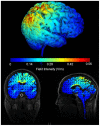Offline Parietal Intermittent Theta Burst Stimulation or Alpha Frequency Transcranial Alternating Current Stimulation Has No Effect on Visuospatial or Temporal Attention
- PMID: 35774555
- PMCID: PMC9237453
- DOI: 10.3389/fnins.2022.903977
Offline Parietal Intermittent Theta Burst Stimulation or Alpha Frequency Transcranial Alternating Current Stimulation Has No Effect on Visuospatial or Temporal Attention
Abstract
Non-invasive brain stimulation is a growing field with potentially wide-ranging clinical and basic science applications due to its ability to transiently and safely change brain excitability. In this study we include two types of stimulation: repetitive transcranial magnetic stimulation (rTMS) and transcranial alternating current stimulation (tACS). Single session stimulations with either technique have previously been reported to induce changes in attention. To better understand and compare the effectiveness of each technique and the basis of their effects on cognition we assessed changes to both temporal and visuospatial attention using an attentional blink task and a line bisection task following offline stimulation with an intermittent theta burst (iTBS) rTMS protocol or 10 Hz tACS. Additionally, we included a novel rTMS stimulation technique, low-intensity (LI-)rTMS, also using an iTBS protocol, which uses stimulation intensities an order of magnitude below conventional rTMS. Animal models show that low-intensity rTMS modulates cortical excitability despite sub-action potential threshold stimulation. Stimulation was delivered in healthy participants over the right posterior parietal cortex (rPPC) using a within-subjects design (n = 24). Analyses showed no evidence for an effect of any stimulation technique on spatial biases in the line bisection task or on magnitude of the attentional blink. Our results suggests that rTMS and LI-rTMS using iTBS protocol and 10 Hz tACS over rPPC do not modulate performance in tasks assessing visuospatial or temporal attention.
Keywords: attention; attentional blink; iTBS; line bisection; rTMS; transcranial alternating current stimulation (tACS).
Copyright © 2022 Moretti, Marinovic, Harvey, Rodger and Visser.
Conflict of interest statement
The authors declare that the research was conducted in the absence of any commercial or financial relationships that could be construed as a potential conflict of interest.
Figures




Similar articles
-
Efficacy of intermittent Theta Burst Stimulation (iTBS) and 10-Hz high-frequency repetitive transcranial magnetic stimulation (rTMS) in treatment-resistant unipolar depression: study protocol for a randomised controlled trial.Trials. 2017 Jan 13;18(1):17. doi: 10.1186/s13063-016-1764-8. Trials. 2017. PMID: 28086851 Free PMC article. Clinical Trial.
-
After-Effects of Intermittent Theta-Burst Stimulation Are Differentially and Phase-Dependently Suppressed by α- and β-Frequency Transcranial Alternating Current Stimulation.Front Hum Neurosci. 2021 Nov 12;15:750329. doi: 10.3389/fnhum.2021.750329. eCollection 2021. Front Hum Neurosci. 2021. PMID: 34867243 Free PMC article.
-
Prolonged continuous theta-burst stimulation is more analgesic than 'classical' high frequency repetitive transcranial magnetic stimulation.Brain Stimul. 2015 Jan-Feb;8(1):135-41. doi: 10.1016/j.brs.2014.10.006. Epub 2014 Oct 18. Brain Stimul. 2015. PMID: 25456979 Clinical Trial.
-
Repetitive Transcranial Magnetic Stimulation for People With Treatment-Resistant Depression: A Health Technology Assessment.Ont Health Technol Assess Ser. 2021 May 6;21(4):1-232. eCollection 2021. Ont Health Technol Assess Ser. 2021. PMID: 34055112 Free PMC article.
-
Efficacy and safety of intermittent theta burst stimulation versus high-frequency repetitive transcranial magnetic stimulation for patients with treatment-resistant depression: a systematic review.Front Psychiatry. 2023 Jul 31;14:1244289. doi: 10.3389/fpsyt.2023.1244289. eCollection 2023. Front Psychiatry. 2023. PMID: 37583841 Free PMC article.
Cited by
-
iTBS over the left hV6A enhances PPC-PPC functional connectivity during reaching tasks: an EEG study.Front Neurosci. 2025 Mar 26;19:1536308. doi: 10.3389/fnins.2025.1536308. eCollection 2025. Front Neurosci. 2025. PMID: 40242457 Free PMC article.
References
-
- Benwell C. S. Y., Learmonth G., Miniussi C., Harvey M., Thut G. (2015). Non-linear effects of transcranial direct current stimulation as a function of individual baseline performance: evidence from biparietal tDCS influence on lateralized attention bias. Cortex 69 152–165. 10.1016/j.cortex.2015.05.007 - DOI - PubMed
LinkOut - more resources
Full Text Sources

